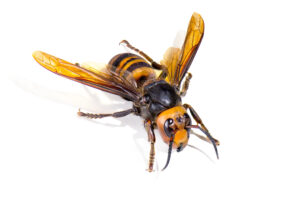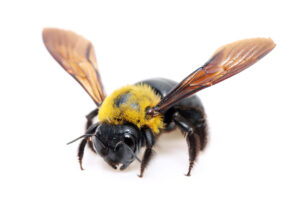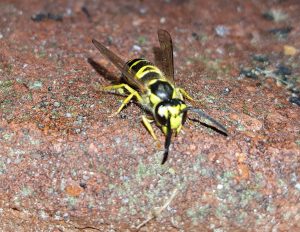What’s With All the Stripes Anyway?
Here in north Georgia, we have lots of flying stripey things! In this article, we are going to try to identify several of these insects so you too are in the know.
Let’s start with the dirt or mud dauber. As the name implies, these guys make their nests using mud. Sometimes, their abodes are rather intricate and have a number of tubes attached together. Some are simply filled in holes they found in wood, masonry, or even furniture surfaces. As far as looks, these guys are anywhere from a half to a little more than an inch long and sport brilliant, almost metallic colors. Dirt daubers are not ones for big group functions and tend to hang out alone. They have been known to sting spiders but don’t typically sting humans. Getting rid of daubers is typically done more by prevention by sealing cracks and keeping your home spider free with regular pest control.
Next, there is the hoverfly. The scientific name is the Syrphid fly and is also known as the flower fly. They look like bees but are actually flies. Bees have 2 sets of wings while flies only have one set. The hoverfly is the most common pollinating fly, usually seen hovering over flowers in search of nectar. It is very interesting to note that pollination is supported by the hoverfly, in specific, on cloudy and cool days. Bees aren’t fans of the poor weather and take the day off, so hoverflies are out there on the job pollinating in our orchards and farms. This little guy can’t hurt you at all but only looks like a scary stinging bee for protection. Leave him be and let him do his thing!

Next up is the cicada killer. There’s nothing like a 2-inch flying insect to instill fear into the hearts of outdoor enthusiasts everywhere. These guys are huge! Cicada killers are just that…they’re after cicadas, not you. Although they can sting if they have no other choice or are stepped on, they are not known to be aggressive to humans. Again, this insect tends to be a loner and shows up most often in late summer as the cicadas are emerging. They live in burrows and like sandy soil that is in full sun.
The humble bumblebee is a prime pollinator and important to our environment. He is pretty easy to recognize because of his, umm, well he’s fat. The bumblebee girls are up to 20 millimeters, the guys are up to 23 millimeters, and the queen herself can be 25 millimeters. They are black and yellow in color and tend to be pretty slow-moving, showing little fear of humans. They are among the first on the scene in the spring and live in the ground in abandoned mammal holes! Bumblebee workers and queens can sting you but are not nearly as likely to do so as hornets, yellow jackets, or honey bees.

Carpenter bees are 14-19 millimeters and have a much larger head than the bumblebee. Like the bumblebee, carpenter bees emerge pretty early in the spring and are valuable as pollinators for our
environment. They are so named for their association with wood. Untreated or dead wood is likely to be a nesting site for this bee as it is known to create a hole around an inch in diameter, thus making is known as a pest. Of note is the nectar robbing tendency of this species. They actually cut into the base of the flower to steal the nectar, permanently damage the poor flower, and then leave without even pollinating! Not kind.
Paper wasps can range in color from reddish-brown to yellow and black. Around homes, they build their nests under the eaves, in your attic, on your porch, and in your shrubbery. When the paper wasps begin to build nests close to your home and family, it is best to get rid of them while it is small in size. As the summer goes on and the number of wasps grow, they become increasingly aggressive. These guys will defend their nests, so beware..
Now on to the yellow jacket. I have a personal grudge against this particular variety of insect having had an extremely painful introduction to the species. They nest in the ground and begin new every year. This is good and bad. It’s hard to find a small number of bees in the early spring, but if you can it’s easier to get rid of a smaller group. These guys are crazy. They eat meat and they love sugary drinks. They are brave to ridiculous levels. They will actually attack bee hives since they can sense the chemical pheromone levels that tell them if the hives are strong or weak. They will eat the larvae and eggs and honey, killing everything in their paths. They are vicious predators. The yellow jacket can be aggressive and dangerous. A professional is your best plan for eradicating this threat.

Lastly in our group is the honeybee. The most well known fact about honeybees is that they produce…drumroll…delicious and nutritious honey. Pollen and nectar collected from spring plants are combined to make honey used by humans and bees alike. Humans have developed a symbiotic relationship with the honeybee, allowing both to thrive in the ideal circumstance. Honey bees live in colonies and are highly social and organized. Honey bees are defensive of their colony and their honey, and even though the workers only have one sting to give, they will do so for the protection of the group. During the attack, pheromones are released from the now dying bee which alerts the rest of the hive to the intruder and threat. Honey bees are believed to visit more than 2000 flowers in a single day! This is hugely important for the production of our food supply and flowers all over the world. Simply put, we need honeybees and all other pollinators. So when they build too close to humans, experts should be called in to assess the situation.
It is important to know the identification of bees and wasps around you. When these insects decide to make their home close to your home, then you could have a problem. For your safety, a professional pest control service is best qualified to identify and deal with infestations of the buzzing kind.
If you have a problem with one of these insects, Canton Termite is happy to help. Call us at 770-479-1598.
Have a happy spring!!
By:Robin
